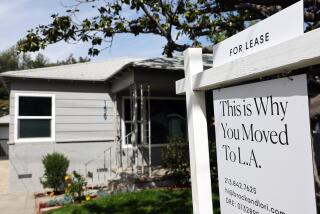Coming Home to a New Idea
Fifth-grader Rafaela Ortega was at the podium, explaining how her new house is different from the aging, gang- and drug- infested public housing project she and her family used to call home.
“My new house is beautiful. It has four bedrooms and two bathrooms,” the 10-year-old said Monday. “The streets are clean. And I know I am safe here.”
Rafaela was speaking at a ribbon-cutting ceremony Monday for a cluster of houses and apartments built on the site of what was once Normont Terrace, a city-run apartment complex in the Harbor City section of Los Angeles. Built in 1942 for shipyard workers, Normont Terrace had been home to 400 low-income families when it was torn down two years ago.
The $83-million rebuilding project, which required nearly 10 years of planning, would have been reason enough for Monday’s celebration. But in the 35-acre development’s new incarnation--as Harbor Village--officials hope they have created even more: a new model for rehabilitating public housing across the nation.
Here, rent-subsidized families on the low rungs of the economic ladder will live cheek by jowl with the middle-class buyers of the moderately priced homes that are sprinkled throughout the development.
Unlike the controversial plan to tear down and rebuild the Aliso Village housing project on Los Angeles’ Eastside, however, this project is adding homes, not subtracting them. All 400 subsidized apartments have been replaced with garden apartments, townhouses or single-family homes. Many of same families, including Rafaela Ortega’s, have moved back.
Once the development is completed, there also will be 224 homes for sale. They will be among the most affordable in the South Bay, with prices ranging from $140,000 to $200,000.
From the start, there were questions about whether people with the means to purchase a home would choose to buy in a public housing project, even a brand new one.
“That was the big issue here,” said William A. Witte, a principal in the Irvine-based Related Cos. of California. The development firm worked with the city Housing Authority and Normont Terrace tenants to design, build and run the new complex.
“There was no model for mixed-income [development],” Witte said. “This is one of the first in the country to redevelop an old public housing project and to do it by combining moderate-income owners with public housing tenants.”
But developers, including Van Nuys-based John Laing Homes, which built and marketed the houses for sale, believed they could be successful with the right combination of security, amenities and location.
The gated community has a 24-hour security guard service. Earth-toned stucco, tiled-roof homes with large windows are clustered along curving streets with landscaped garden areas and play yards. Community facilities include a large swimming pool, a patio area, an elegantly furnished meeting room, a computer work room and a gym with weight machines, treadmills and stationary bicycles.
Located along Vermont Avenue near Pacific Coast Highway, not far from the Harbor Freeway and the Port of Los Angeles, Harbor Village is close to jobs, stores, a large park and bus lines. The first 50 homes were snapped up, as were 15 of those waiting to be built.
The project was financed with nearly $30 million in federal low-income tax credits, a $6-million loan from the city’s Housing Department and several private investors, including the California Public Employees Retirement System. Organized labor put in $15.1 million--in the form of a loan from the Union Labor Life Insurance Co.--and hired and trained tenants to work as carpenters, electricians, plasterers and painters.
Olga Avalos, a breakfast and lunch aide at nearby Normont Elementary School, said she was delighted to be back at the place she and her husband called home for 25 years. They raised their six children there.
Now they live alone in a two-bedroom townhouse that is big enough to accommodate visiting grandchildren. She likes the spacious closets, the dishwasher and the space for her washer and dryer off the efficient, modern kitchen.
“We all get along here,” Avalos said. “We have blacks, Latinos, Filipinos, and we all know each other, watch out for each other.”
With the new security fence ringing the complex and the security guard at the gate, Avalos said she feels safe.
“It’s so nice and peaceful here in the evenings now. We don’t have [gang members] doing something and running in here and getting [the residents] blamed for it. . . . Now we can have that little bit of pride.”
More to Read
Sign up for Essential California
The most important California stories and recommendations in your inbox every morning.
You may occasionally receive promotional content from the Los Angeles Times.







